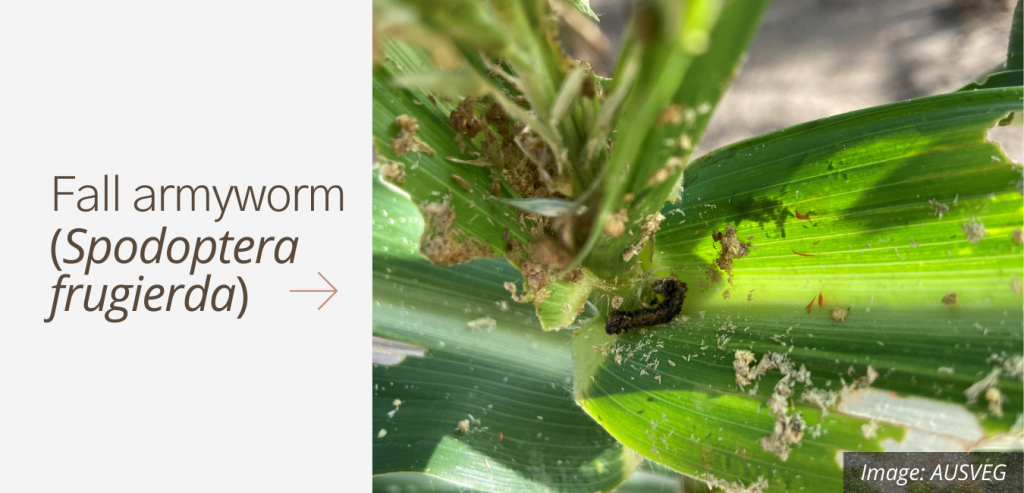Biosecurity Alerts
Tomato-potato psyllid (Bactericera cockerelli)
Last updated September 2021
TPP has only been detected in Western Australia. Currently, there have been no reported cases of Candidatus Liberibacter solanacearum in Australia.
The current situation
Tomato Potato Psyllid (TPP) is a small sap sucking insect that feeds on solanaceous plants (tomatoes, potatoes, capsicums, eggplant etc.), but has also been observed in other plant families, including Convolvulaceous e.g. sweet potato. The pest can minimise plant growth and cause crop losses through its feeding habits. It is the primary vector for Candidatus Liberibacter solanacearum (CLso), the pathogen that causes the disease ‘Zebra Chip’.
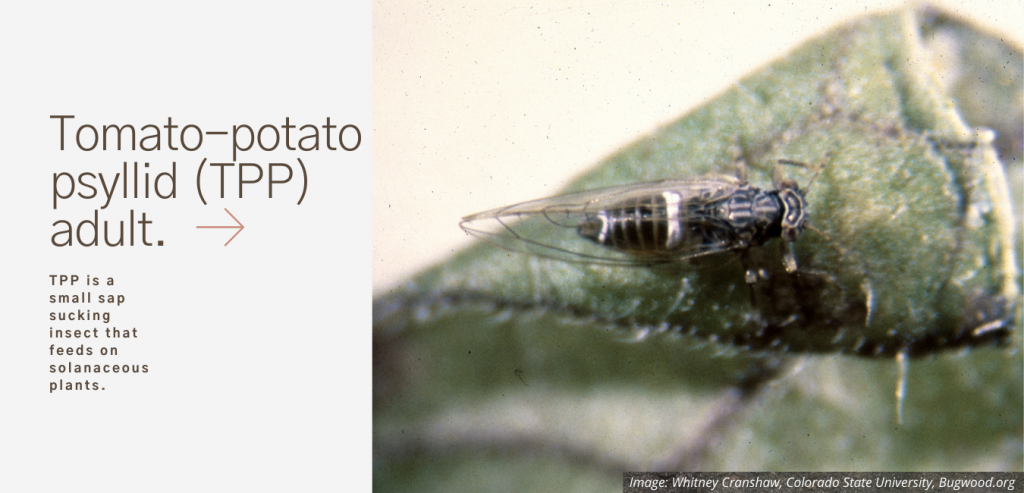
TPP was detected in Western Australia (WA) in February 2017 and biosecurity measures were immediately put in place. The Consultative Committee on Emergency Plant Pests (Australia’s key technical body for coordinating national responses to emergency plant pest incursions) determined that TPP could not be eradicated from Australia and the Transition to Management plan was developed. The Department of Primary Industries and Regional Development Western Australia (DPIRD WA) led the implementation of the plan, working closely with industry and the national TPP coordinator, Alan Nankivell, appointed through AUSVEG.
The plan included the following major activities:
- Targeted surveillance for TPP/CLso complex during Spring 2017 and Autumn 2018 in WA.
- Scientific research to improve understanding of TPP, its biology and options for control.
- Management of TPP through the development of national and enterprise management plans.
- Market access and trade.
The Transition to Management plan ended in June 2018 and was succeeded by the Tomato Potato Psyllid National Management Plan. The National Management Plan aims to prevent the spread of TPP outside of already infected areas, reduce the impact of TPP within those areas, and protect domestic and international trade.
For more information about the plan, please contact AUSVEG at science@ausveg.com.au or on (03) 9882 0277. The full text of the Tomato Potato Psyllid National Management Plan is available here.
About the pest
TPP is a small psyllid, approximately 3 mm in length when fully developed. TPP has three life stages – egg, nymph, adult.
Eggs are small (less than 1mm long) and white when laid. After a few hours they turn yellow.
Nymphs are flat and oval shaped with a scale-like appearance. Nymphs moult five times before maturing to adults. Generally, nymphs grow to 2mm in length.
Adults are brown in appearance, resemble small, winged cicadas and are approximately 3 mm in length. Adults can fly short distances, but can also be spread via wind. The thorax (middle section of insect’s body) of an adult has white to light yellow markings, with a distinct white band. Their wings are transparent and held vertically over the body.
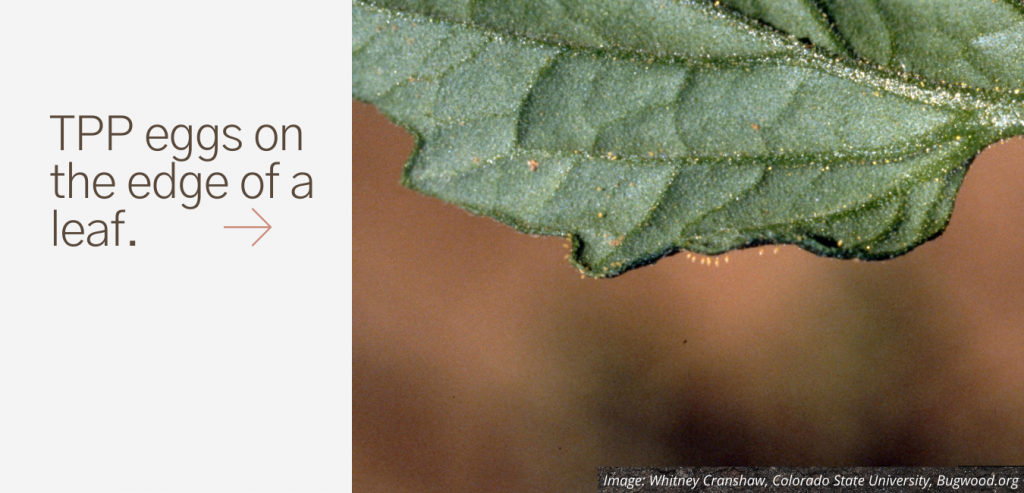

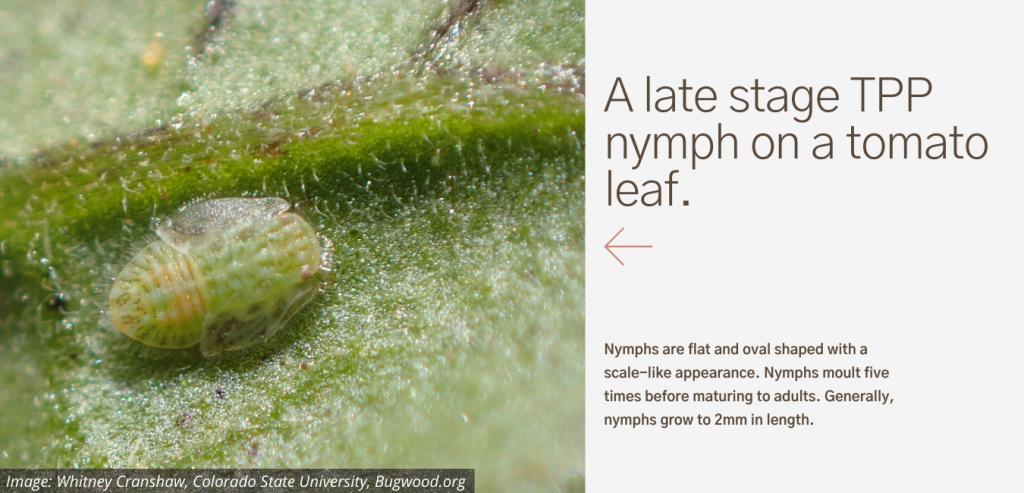
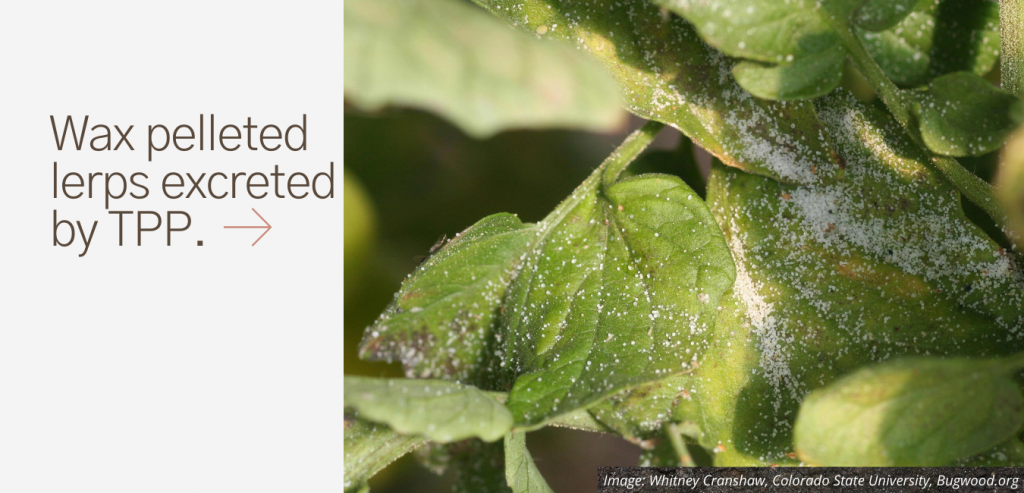
Impacts to trade
TPP can be rapidly spread through the movement of infected plant material. There is currently a Quarantine Area Notice (QAN) currently in place for Metropolitan Perth and selected surrounding Local Governments Areas (LGA) in WA. It applies to the movement of TPP host plants produced in quarantined areas to other parts of Australia. The QAN applies to commercial and home-grown plants. The list of plants covered includes, but is not limited to, potatoes, capsicums, and chillies. Prescribed treatment is required for host plants, such as seedlings or nursery stock, when they are moving from the Quarantine Area to specific local government areas in WA.
- For a full list of LGA’s included in the QAN, click here.
- For a list of the host materials covered by the QAN, click here.
- For more information on interstate trade/market access, click here.
Advice
TPP can spread through the movement of tomato, capsicum, eggplant, tamarillo and other solanaceous plant material. It can also spread on other plant hosts including plants within the Convolvulaceae family (e.g. sweet potato). Additionally, it can disperse through natural pathways such as flight and via wind.
Growers in WA that grow affected crops should regularly check and monitor crops for TPP. More information about the pest and the bacterium it can vector between plants is available here: https://www.agric.wa.gov.au/tomato-potato-psyllid-tpp
Implement good farm biosecurity procedures to prevent the entry, establishment and spread of pests and diseases. More information on biosecurity practices can be found here: https://www.farmbiosecurity.com.au/
Report
Report sightings of unusual insects or plant damage through the MyPestGuide Reporter app or by contacting the department on 1800 084 881.
If you suspect you have TPP outside of the current distribution range, contact your state or territory department of agriculture or primary industries through the Exotic Plant Pest Hotline on 1800 084 881.
DISCLAIMER: The material on this webpage is for general information only and no person should act, or fail to act on the basis of this material without first obtaining professional advice. AUSVEG and all persons acting for AUSVEG expressly disclaim liability with respect to anything done in reliance on this publication.
Dickeya dianthicola
Last updated August 2021
The current situation
Dickeya dianthicola is a bacterium that can cause tuber soft rot and blackleg in potatoes. It can also affect other crops, including chicory, globe artichokes and some ornamentals (e.g. carnations, lilies, chrysanthemums, dahlias, begonias, flaming katies, freesias, hyacinths, and irises). Overseas, research suggests that it can cause significant yield losses in potato crops.
The bacterium was first detected in Australia in June 2017 in a commercial seed potato crop in Western Australia (WA). Since then, the bacteria has been found in dahlia tubers and freesia bulbs imported from Victoria. Growers of these crops are urged to check plants and tubers and report any suspect symptoms.
Other pathogens already present in Australia can cause similar soft rot and blackleg symptoms. Dickeya dianthicola is more aggressive but causes disease at lower infection levels. This means it is generally harder to detect in crops.
This pest is not associated with the tomato potato psyllid. There are currently no known outbreaks of Dickeya dianthicola in Victoria.
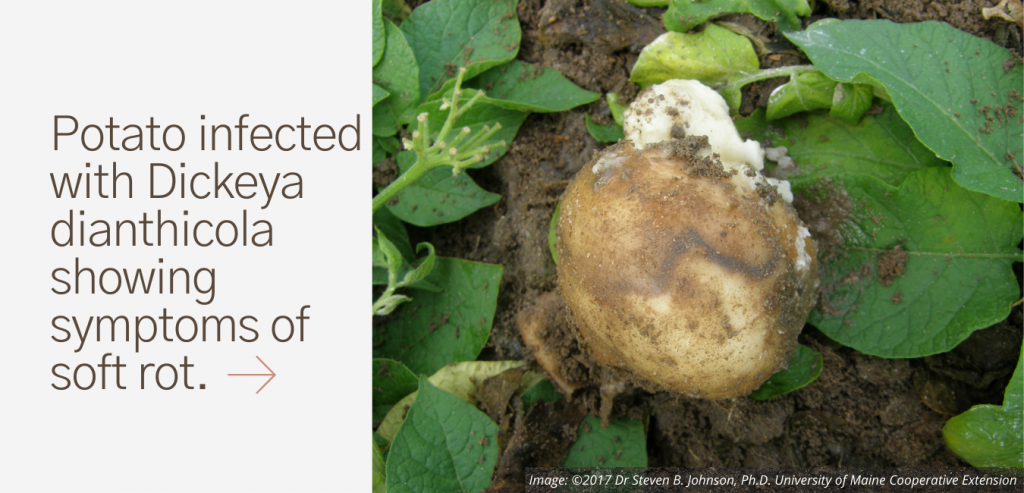
The current response
Based on a recommendation from the Consultative Committee on Emergency Plant Pests (Australia’s key technical body for coordinating national responses to emergency plant pest incursions), the National Management Group (NMG) determined that it was not technically feasible to eradicate Dickeya dianthicola from Australia. The Department of Primary Industries and Regional Development Western Australia (DPIRD WA), in conjunction with the WA potato industry, will implement a management strategy for Dickeya dianthicola following the decision that it cannot be eradicated.
The Potato Growers Association of WA (PGAWA) will lead management efforts to minimise impacts to industry. This includes raising grower awareness of buyer responsibility to understand the risks of spread. DPIRD WA will provide technical advice, fee for service laboratory testing and will work with PGAWA to modify the Certified Seed Scheme and Registration Rules to manage the disease.
About the disease
Generally, the first symptom of the disease can be poor emergence due to rotting seed tubers. Plants wilt and typically have slimy, wet, black stems extending upwards from the rotting tuber. Infected tubers are macerated and have a tapioca-like appearance. They can sometimes have a pungent smell, which can be associated with blackleg.
Overseas, research indicates that Dickeya dianthicola can also cause soft rot and wilting in ornamental crops.
Dickeya dianthicola can be present in a plant without causing symptoms, particularly if temperatures are low and not suited to disease development. Symptoms often develop after a period of hot weather, especially in cases where plants are stressed.
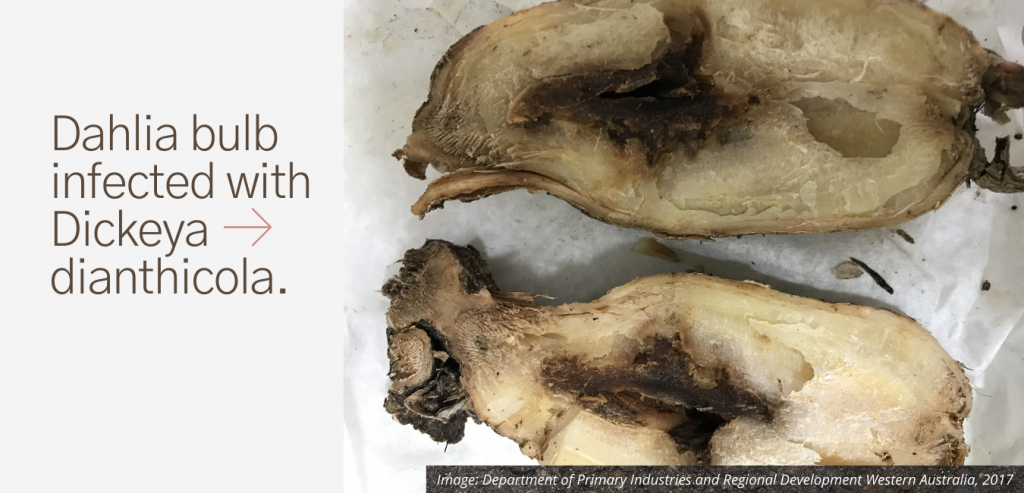

How does it spread?
In potatoes, the main source of spread is latently infected seed tubers.
Overseas, research indicates that as infected tubers rot, the bacterium is released into the soil. It can then be transmitted through water in the soil and contaminate neighbouring tubers. Infected stems can also impact neighbouring plants through contaminated irrigation water.
Additionally, infection has been shown to spread to other tubers during storage. Overseas research indicates that Dickeya dianthicola does not survive long in soil without a host plant. However it can survive in soil between potato crops where there is remaining plant debris or when volunteer potato plants (and other hosts) are present.

Host list
- Potato
- Globe artichoke
- Chicory
- Begonia
- Calla lily
- Carnation
- Chrysanthemum
- Dahlia
- Dianthus
- Sweet William
- Freesia
- Hyacinth
- Iris
- Kalanchoe
Impacts to trade
- There are currently no additional interstate trade restrictions for potatoes apart from the restrictions in place for the Tomato-potato psyllid.
- The international market access for WA potatoes remains unaffected.
- Trade in cut flowers from WA is already subject to interstate movement conditions for other pests.
- The Australian Government Department of Agriculture and Water Resources will work with overseas trading partners should any issues arise.
- The bacterium does not have an impact on human health.
For more information, visit the DPIRD website.
Advice
Management techniques that have previously been developed for soft rot diseases in potatoes may potentially be useful for growers affected by Dickeya dianthicola. More information is available on DPIRD WA webpage on soft rot diseases of potatoes.
Ensure all seed potatoes that are purchased are certified by a relevant authority (i.e. DDLS Seed Testing and Certification, AuSPICA).
Additionally, on-farm biosecurity practices including good farm hygiene and reporting of suspicious disease (or pest) symptoms have the potential to prevent the entry, establishment and spread of Dickeya dianthicola. For more information on biosecurity practices to implement on-farm, go to the Farm Biosecurity website.
DISCLAIMER: The material on this webpage is for general information only and no person should act, or fail to act on the basis of this material without first obtaining professional advice. AUSVEG and all persons acting for AUSVEG expressly disclaim liability with respect to anything done in reliance on this publication.
Brown marmorated stink bug (Halyomorpha halys)
Last updated August 2021
The current situation
The Brown marmorated stink bug (BMSB) is a high priority pest that is often found in cargo entering Australia from the northern hemisphere.
The threat of incursion increases between September and April and each year, and seasonal measures are put in place at Australia’s border to prevent BMSB from entering Australia. The seasonal measures for the 2021-2022 season apply for cargo shipped between the 1st of September 2021 and the 30th of April 2022, from countries deemed to be target risks. Cargo is inspected and, if BMSB is detected, subject to treatment.
Two post border detections were made in 2018 (both in New South Wales) and six were made in 2019 (in Victoria, Western Australia, and Queensland). While there are no currently listed outbreaks of BMSB in Australia, it remains a threat and border detections are common.
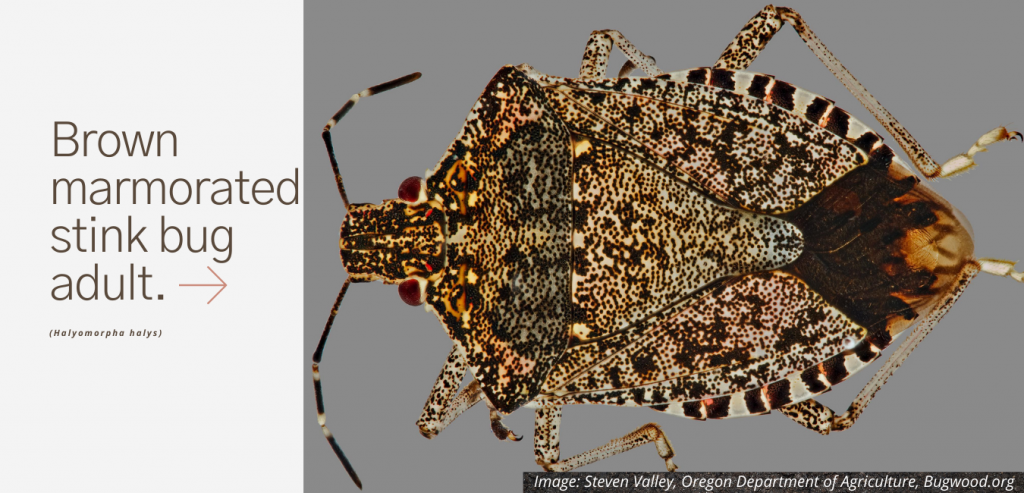
About the pest
BMSB is native to eastern Asia but has been introduced to parts of North America and Europe. Its preferred vegetable hosts include capsicums, sweet corn, okra, tomatoes, green beans, and eggplant. However, it is known to feed on more than 300 host crops.
BMSB has three live stages: egg, nymph, and adult.
Eggs are cream to yellow-orange, approximately 1.6 mm long and white and laid in groups of 15-20 on the underside of leaves.
There are five nymph stages that range from smaller than 3 mm to 12 mm long. Nymphs have a dark head with an orange to red body.
Adults are mottle brown coloured, shield shaped stink bugs and range from 12-17 mm long. Adult’s legs and antennae have white bands or dots.
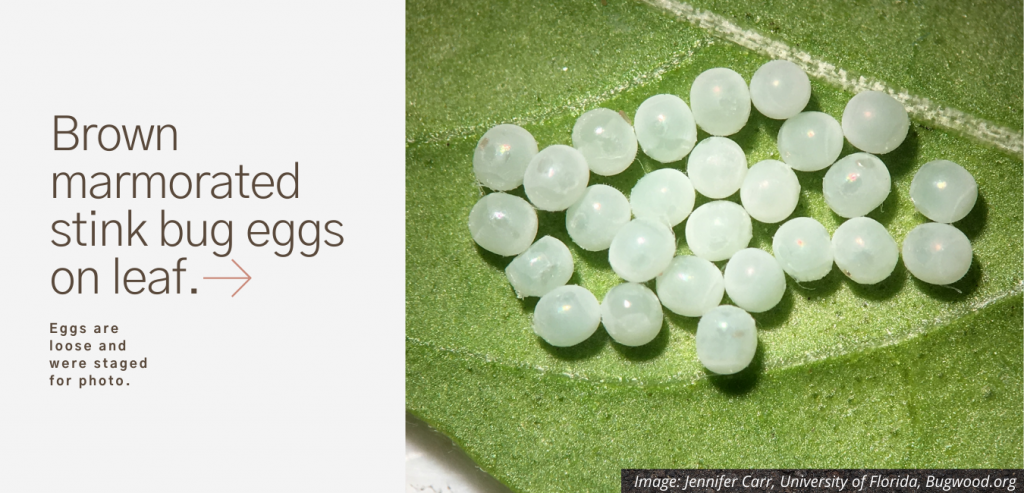
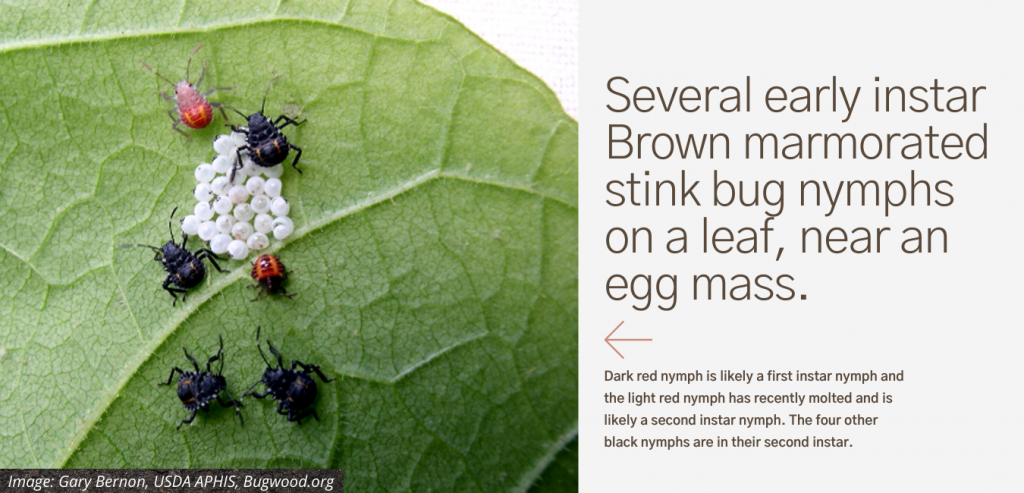
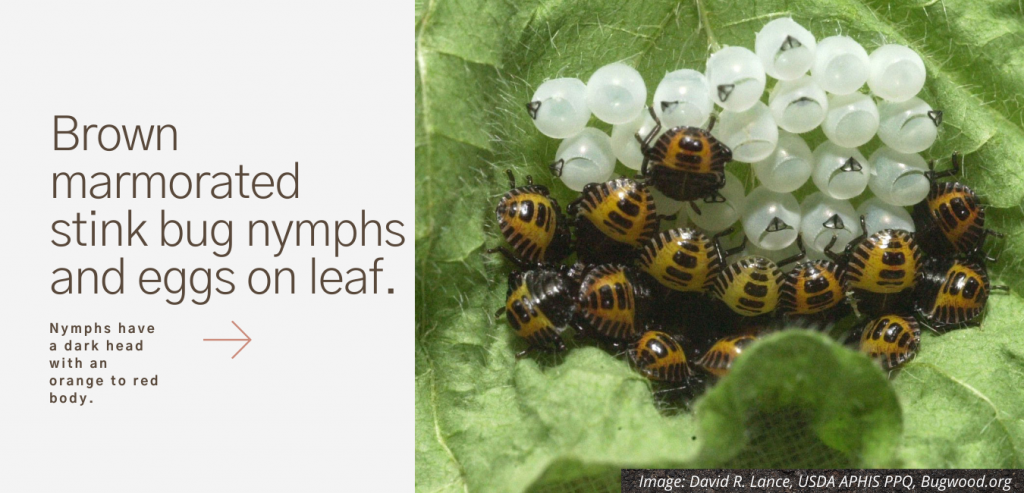
Impacts to trade
BMSB poses a risk to Australia’s horticulture sector through direct crop damage and, potential exclusion from foreign export markets if an outbreak were to occur and become severe.
Export
As Australia is currently declared BMSB free, there are no regulations in place for the pest for any goods or produce exported from Australia.
Import
Imported goods from certain target risk countries are subject to the seasonal measures listed above. A full list of these countries is available of the Department of Agriculture, Water, and the Environment (DAWE)webpage: Seasonal measures for Brown marmorated stink bug (BMSB).
Domestic
There are currently no domestic border restrictions related to BMSB.
Advice
Broad spectrum insecticides have been demonstrated to reduce, but not completely eradicate, BMSB populations in the United States. However, these chemicals pose a risk to natural enemies and beneficial insects.
There are currently no known biological control agents available for BMSB in Australia.
If you suspect you have seen BMSB, report it to the Exotic Plant Pest Hotline (1800 084 881) or via the MyPestGuide Reporter app.
Click here to visit the Department of Agriculture’s website.
Click here to access a factsheet that provides more information on the BMSB.
Click here to access the Department of Agriculture’s Import Industry Advice Notices.
DISCLAIMER: The material on this webpage is for general information only and no person should act, or fail to act on the basis of this material without first obtaining professional advice. AUSVEG and all persons acting for AUSVEG expressly disclaim liability with respect to anything done in reliance on this publication.
Candidatus Liberbacter solanacearum (CaLsol or CLso) detected in imported parsley seed (NSW)
Last updated: 2017
A bacterial plant pathogen, Candidatus Liberibacter solanacearum (CaLsol or CLso), was detected in the Italian Giant variety of imported parsley seed in 2017. These seeds originated in France. However, they were imported through a supplier in Italy.
The detection occurred in an imported commodity and therefore the bacterium is not currently considered present in Australia.
Visit the NSW Department of Primary Industry’s website for more information.
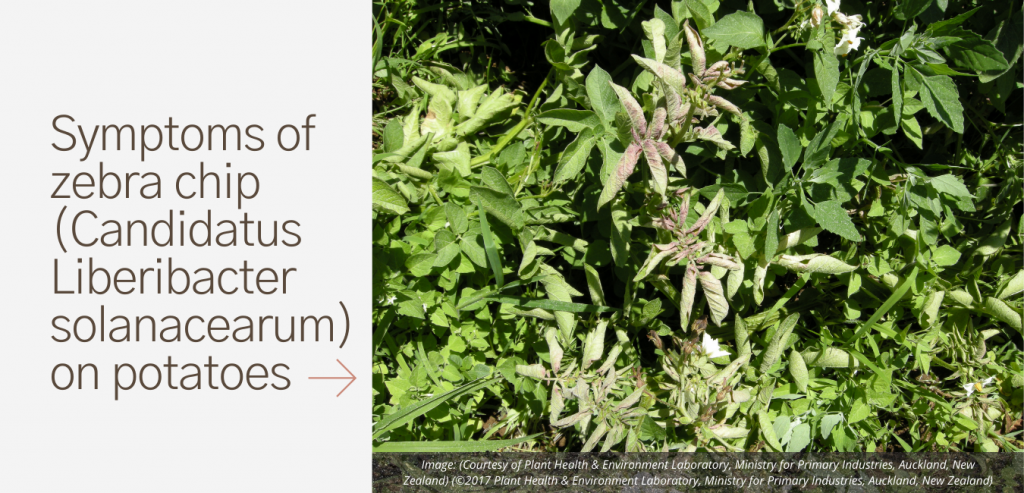
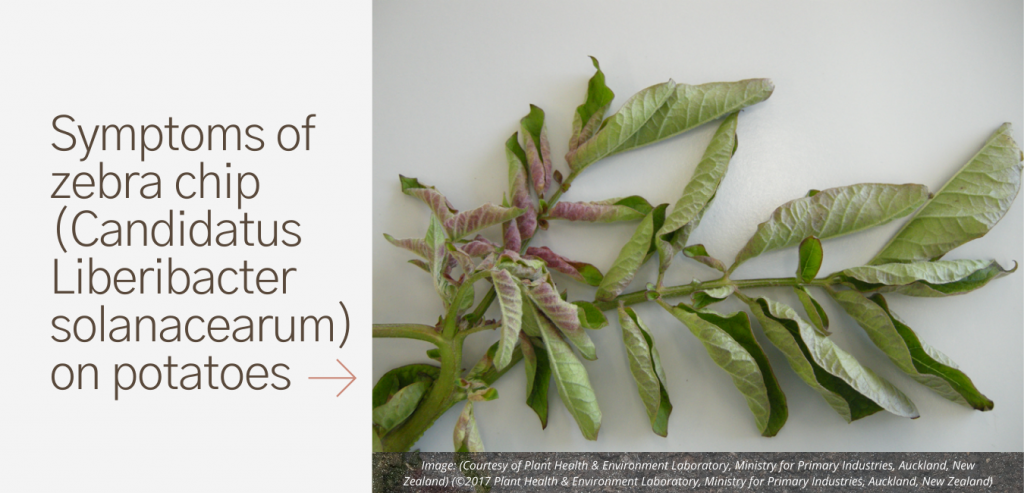 DISCLAIMER: The material on this webpage is for general information only and no person should act, or fail to act on the basis of this material without first obtaining professional advice. AUSVEG and all persons acting for AUSVEG expressly disclaim liability with respect to anything done in reliance on this publication.
DISCLAIMER: The material on this webpage is for general information only and no person should act, or fail to act on the basis of this material without first obtaining professional advice. AUSVEG and all persons acting for AUSVEG expressly disclaim liability with respect to anything done in reliance on this publication.
Impatiens necrotic spot virus (Impatiens necrotic spot orthotospovirus)
Last updated September 2021
The current situation
Impatiens necrotic spot virus (INSV) is an exotic plant virus which can infect more than 600 plant species, including many important vegetable crops grown in Australia. The virus has similar biology to Tomato spotted wilt virus, which is widespread throughout Australia.
In the last 11 years, there have been two reported outbreaks of INSV. In 2010, the virus was detected in ornamental plants on a property in New South Wales (NSW). This outbreak was contained and the virus was eradicated. In January 2018, a second outbreak was detected in a lettuce crop on a property in Elderslie, NSW. In this case, the Consultative Committee for Emergency Plant Pests determined that it was not technically feasible to eradicate the virus. It is unclear how these two outbreaks occurred.
Since 2018, there have been no further reported cases of INSV in Australia and there are currently no known outbreaks.
About INSV
Impatiens necrotic spot virus can be spread by Western flower thrips (WFT) (Frankliniella occidentalis), which are established in most states and territories across Australia. WFT larvae obtain the virus by feeding on infected host plants. Adult WFT can transmit the virus to healthy plants by directly feeding on healthy plants for anywhere between 5 to30 minutes. Other thrip species have not been identified as vectors of INSV.

Symptoms of plants infected by INSV include stunted plant growth, ringspots (brown or purple spots on leaves and stems), and plant death. Symptoms vary between plants and some plants can be asymptomatic.
More information on INSV and other thrip borne viruses is available in this publication by the Queensland Department of Agriculture and Fisheries.

Impacts to trade
There is currently no INSV-specific trade or plant movement restrictions in place. However, INSV is a declared pest for many states.
Advice
An outbreak of INSV could be severe and poses a significant risk to the horticultural industry, especially the vegetable and potato industries.
If you suspect that your crop may be infected with INSV, contact the Exotic Plant Pest Hotline on 1800 084 881.
More information can be found in Plant Health Australia’s contingency plan for Thrips transmitted viruses.
DISCLAIMER: The material on this webpage is for general information only and no person should act, or fail to act on the basis of this material without first obtaining professional advice. AUSVEG and all persons acting for AUSVEG expressly disclaim liability with respect to anything done in reliance on this publication.
Fall armyworm (Spodoptera frugierda)
Last updated September 2021
The fall armyworm (FAW; Spodoptera frugiperda) is a destructive moth that attacks more than 350 plant species.
Affected vegetable crops include sweet corn, beetroot, tomato, onion, cauliflower, cucumber, lettuce and potato. Other crops affected include maize, rice, sorghum, sugarcane and wheat.
FAW is a pest native to tropical and sub-tropical regions of the Americas and has spread worldwide. It was first detected in Australia in February 2020 in northern Australia, including Queensland (QLD), Northern Territory (NT) and Western Australia (WA). Specifically, FAW was detected in the Torres Strait Islands of Sabai and Erub, Bamaga in Cape York, Georgetown, South Johnstone, Tolga, Lakeland, Burdekin and Bowen; Katherine, NT; and Kununurra, Broome and Carnarvon, WA.
Since then, it has been detected in key growing regions of New South Wales, Victoria and Tasmania. Its range expansion can be attributed to transportation by infected produce and its strong flying abilities, however, its invasiveness can be attributed to its ability to adapt to its environment.
Description:
FAW has four life stages – egg, larvae, pupa and adult (moth).
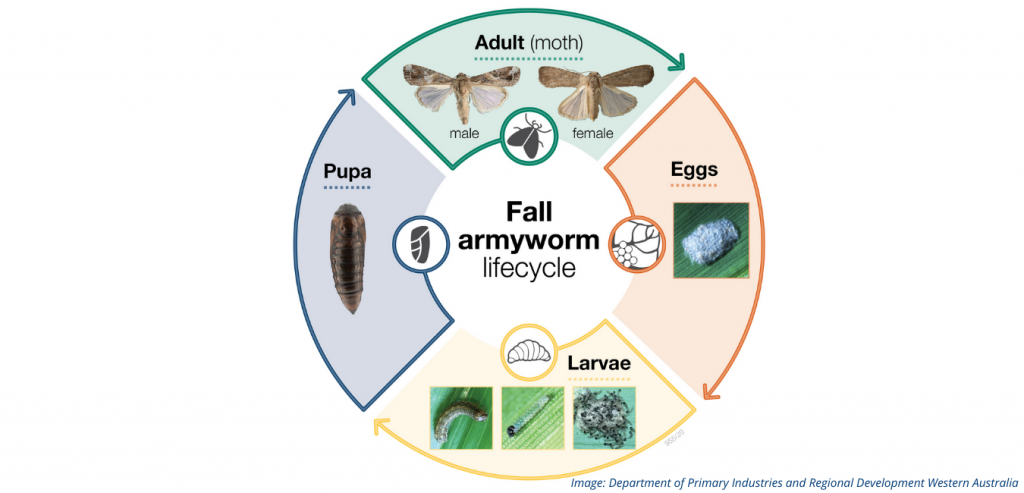 Eggs
Eggs
- Pale yellow in colour and clustered together in a mass.
- An egg mass can contain 100–200 eggs.
- Egg masses are usually attached to foliage in a mound, with a silk-like furry substance.
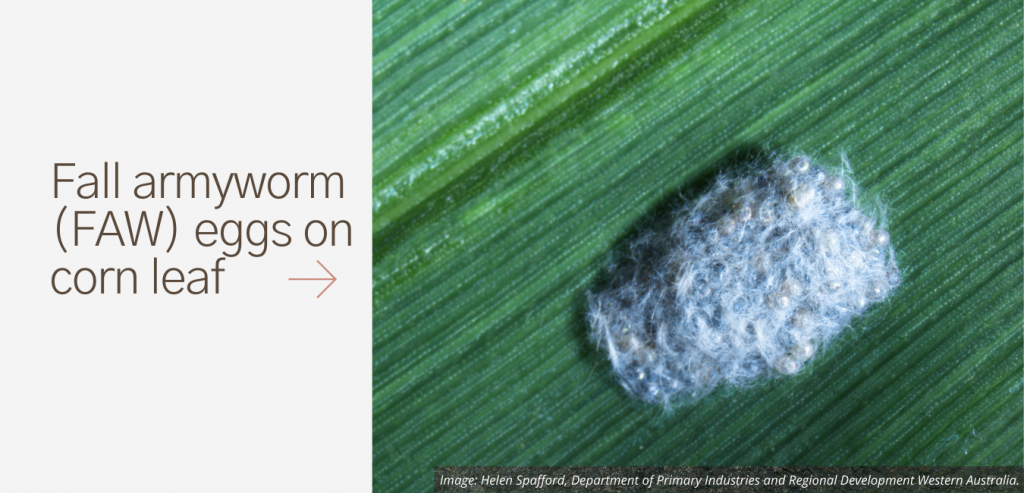
Larvae (caterpillar)
- Young larvae are approx. 1.7mm long, light in colour with a large, dark head.
- Older larvae are grey-brown, with length ways stripes and dark spots along the upper surface of its body.
- Larvae can reach a length of 34mm.
 Pupa
Pupa
- Caterpillars will burrow into the soil and pupate (develop) into adults.
- Pupa are shiny and brown cocoons.
Adult
- Moths are approx. 15-20mm long (nose to tail) when resting.
- Brown-grey forewing; White hindwing.
- Male FAW adults have more patterns and a distinct white spot on each forewing.
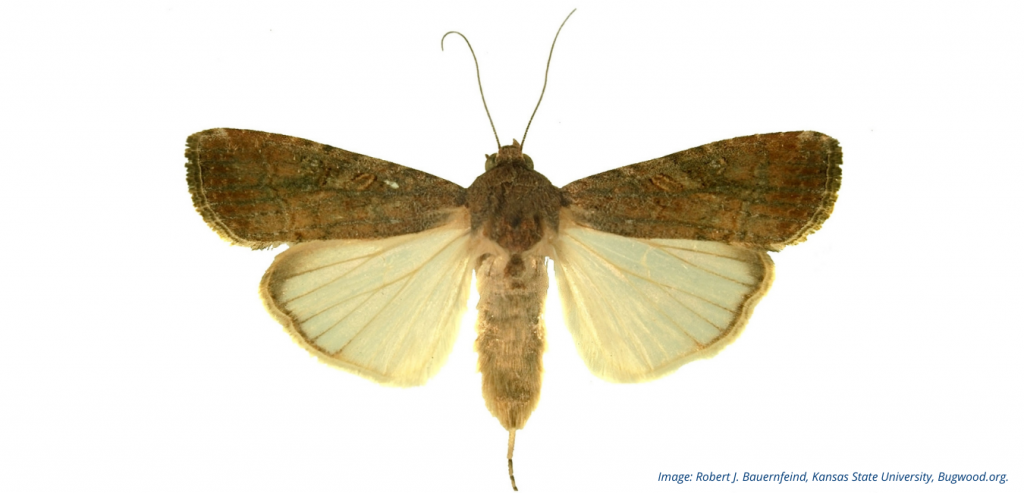
Watch out for FAW look-a-likes:
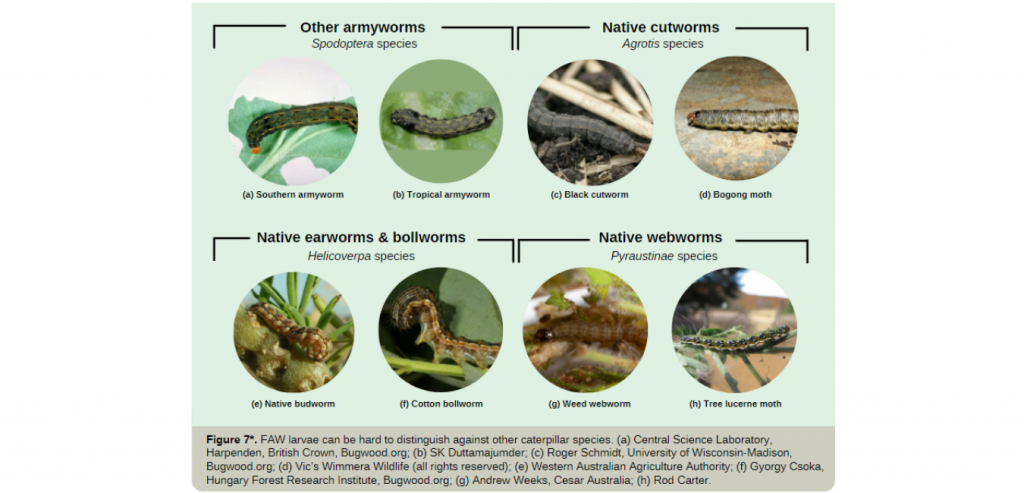
Damage
Damage is caused by FAW larvae (caterpillars) consuming foliage and attacking leaves, stems, shoots and fruit. Damage includes pinholes or windows, leaf tattering or complete defoliation.
The larger the caterpillar, the more significant the damage. FAW are nocturnal, laying eggs and causing feeding damage at night.
Damage caused by FAW can reduce plant growth, crop yield and cause plant death. Severe infestations can destroy crops almost overnight. It may also impact our environment as some of Australia’s native grasses are hosts.
Hosts
FAW has approximately 350 plant hosts. These include economically important cultivated grasses such as maize, rice, sorghum, sugarcane and wheat but also other vegetable and fruit crops and cotton.
Click here to view the full list of known hosts.
Spread
FAW adult moths are capable of flying long distances, with females flying up to 100 kilometres in a night or 500 kilometres in a lifetime. In the Americas, adult moths can undertake annual seasonal migration as far north as Canada.
The pest can also spread via people. The arrival of FAW in Africa is believed to have occurred from a passenger flight. The illegal importation or movement of infested plant material also represents a significant risk to spreading the pest to a greater distribution.
The Australian Government closely regulates approved imports of plant material and monitors for illegal plant movement.
Integrated pest management
Prevention
The key to efficient control of FAW is an integrated pest management (IPM) program, inclusive of an artillery of sustainable practices that are effective against FAW. Cultural farm practices, biological control or preservation of natural enemies, as well as conventional chemical applications offer opportunities for future management of FAW.
Useful resources:
Monitoring and action
Early detection of FAW ensures a quick response and accurate timing of control methods. Regular crop surveillance and monitoring for FAW eggs and larvae is the foundation of a successful IPM program and helps minimise damages and reduce harvest losses.
Inspect your plants regularly for the presence of unusual pest and disease symptoms.
To help identify symptoms of FAW, examine plants for:
- leaf damage, including pinholes, windowing, tattered leaf margins, skeletonization and defoliation of plants
- tiny larvae, less than 1mm, that are more active at night, eating pin holes and transparent windows in leaves
- bigger larvae grazing on leaves, stems, trunk and fruit, and leaving behind insect frass (droppings)
- in grass-like plants, larvae are often in plant whorls (where leaves radiate from or wrap around the stem or stalk (see image below)
- sudden crop damage and collapse.
Legal requirements
The Australian Department of Agriculture, Water and the Environment have specific import conditions that are in place for important plants and plant products.
Click here to find out more.
AUSVEG FAW resources
- Fall armyworm – Biosecurity alert
- Fall armyworm – What to look for (video)
- Fall armyworm Webinar Series
- Fall armyworm – Fact sheet (Published 2020)
External information and resources on FAW
- Plant Health Australia’s Fall Armyworm Podcast series
- Queensland Department of Agriculture and Fisheries – Fall armyworm
- Northern Territory Government – Fall armyworm
- Western Australia Department of Primary Industries and Regional Development – Fall armyworm in Western Australia
DISCLAIMER: The material on this webpage is for general information only and no person should act, or fail to act on the basis of this material without first obtaining professional advice. AUSVEG and all persons acting for AUSVEG expressly disclaim liability with respect to anything done in reliance on this publication.
Serpentine leafminer (Liriomyza huidobrensis)
Last updated September 2022
Current situation
The once exotic Serpentine leafminer species from the Agromyzidae family poses a significant economic threat to Australia’s horticulture and nursery production plant industries.
It has a wide host range beyond 250 plant species which includes beans, beet, broccoli, cabbage, capsicum, celery, chilli, cucumber, eggplant, lettuce, onions, peas, potatoes, spinach, tomatoes, ornamental plant and, cut flowers. It also has a number of weed hosts.
The pest is wind borne and eggs, larvae and pupae can be spread through the movement of plant material, soil, clothing, and equipment.
Serpentine leafminer damage is primarily caused by larvae feeding under the surface of leaves. Typically, this feeding causes long, narrow, serpentine-shaped ‘mines’ which appear as white or grey lines on leaves.
In November 2020 shortly after the initial detection Serpentine leafminer was detected in the Fassifern Valley, Queensland.
In August 2021, Serpentine leafminer was detected in the Lockyer Valley, southeast Queensland.
On 17 June 2022, Serpentine leafminer was found infesting a vegetable farm in Werribee, Victoria. Agriculture Victoria. The pest Serpentine leafminer is now considered established in New South Wales, Queensland, and Victoria.
Worldwide, Serpentine leafminer is found in Africa, Asia, Europe, North and South America.

Initial detection
On 22 October 2020 a grower in Western Sydney phoned the Exotic Plant Pest Hotline and reported the presence of suspected exotic leafminer on his property.
When the property was inspected on 23 October, several vegetable hosts were infested, with the infestation having spread across the property.
Live and dead specimens were collected and submitted for diagnostic testing.
On 29 October 2022 the specimens were identified as serpentine leafminer.
This identification was confirmed on 2 November. Secondary testing by the Department of Agriculture, Water and the Environment confirmed this.
The New South Wales Department of Primary Industries (NSW DPI) established an Incident Management Team and Local Control Centre to coordinate the response. Infested sites have been assessed to inform further actions which may include treating host plants with pesticides and removal and destruction of severely infested host plants.
The Consultative Committee on Emergency Plant Pests met on 6 and 23 November 2020 to discuss the incident. The committee agreed to recommend that the serpentine leafminer is an emergency plant pest.
The Consultative Committee on Emergency Plant Pests met on 23 November 2020 to discuss the incident. The committee agreed to recommend to the National Management Group that the serpentine leafminer is an Emergency Plant Pest as defined by the Emergency Plant Pest Response Deed.
However, due to the locations of the incident, the current spread of the pest, and the pest’s biology that includes a diverse host range, the committee agreed to recommend that it is not technically feasible to eradicate.
Damage
Serpentine leafminer damage is primarily caused by larvae feeding under the surface of leaves.
Typically, this feeding causes long, narrow, serpentine-shaped ‘mines’ which appear as white or grey lines on leaves.
High levels of infestation affect the plant’s ability to photosynthesise, reducing plant growth, and crop yields.
Have you seen an exotic leafminer webinar
Public advice and reporting
Production nurseries and growers should always check their crops regularly for signs of plant pests and disease. If you suspect a serpentine leafminer infestation, report it to the department of primary industries or agriculture in your state or territory. You can do this by phoning the Exotic Plant Pest Hotline on 1800 084 881.
In areas where SLM is considered established you are under no obligation to do this.
Good on-farm biosecurity practices are vital to preventing incursions of plant pests and diseases. The farmbiosecurity.com.au website has helpful information that can be tailored to your property.
Host crops
SLM has a wide host range of plant species which includes beans, broccoli, cabbage, capsicum, celery, chilli, cucumber, eggplant, lettuce, onions, lettuce, onions, peas, potatoes, tomatoes, cut flowers and ornamental plants.
It also has a number of weed hosts.
Control methods
Serpentine leafminers are most damaging when beneficial parasitoids are removed due to the use of non-selective insecticides (Cesar Australia 2018; Murphy and LaSalle 1999).
For the ongoing management of leafminers it is important that chemicals are selected that are reasonably selective and have low toxicity towards key beneficial parasitoids.
For more information regarding minor use permits, check out this Hort Innovation Serpentine Leafminer update page.
For further information on permits, check the Australian Pesticides and Veterinary Medicines Authority (APVMA) website.
Minor Use Permits as at 24/11/2020
| Permit ID | Description | Dates | Permit Holder | Jurisdiction | Permit Download |
| PER81867
Version 2 |
Cyromazine (Diptex 150 WP Insect Growth Regulator) / Various Vegetables / Liriomyza species, including: Vegetable Leafminer
(Liriomyza sativa), Serpentine Leafminer (Liriomyza huidobrensis)
|
2 December 2019 – 30 November 2023 | Hort Innovation | All states and territories | PER81867 |
| PER87878 | Spinetoram (Success Neo/Delegate) / Snow Peas & Sugar snap peas / Liriomyza Leafminers |
11-Feb-2020 to 28-Feb-2020 | Hort Innovation | All states and territories except Victoria | PER87878 |
| PER88640 | Spirotetramat (Movento 240 SC) / Snow Peas, Sugar Snap Peas, Lettuce (Head lettuce and Leafy lettuce), Parsley, Green Beans, Celery, Rhubarb, Eggplant, Capsicums, Chilies & Tomatoes /
Liriomyza leafminers (Liriomyza spp.) (including Vegetable leafminers, Pea leafminer and American serpentine leafminer)] Suppression only |
18-May-20 to 31-May-23 | Hort Innovation | All states and territories except Victoria | PER88640 |
| PER87878 | Spinetoram (Success Neo/Delegate) / Snow Peas & Sugar snap peas / Liriomyza Leafminers |
11-Feb-2020 to 28-Feb-2020 | Hort Innovation | All states and territories except Victoria | PER87878 |
| PER87631
Version 2 |
Chlorantraniliprole / Spinach & Silverbeet / Leafminers (Liriomyza spp.) including:
Cabbage leaf miner (Liriomyza brassicae), Vegetable leaf miner (Liriomyza sativae) & Serpentine leaf miner (Liriomyza huidobrensis) (suppression only) |
19-Jun-2019 to 30-Jun-24 | Hort Innovation | All states and territories | PER87631 |
Further reading and available resources:
- Management plan.
- Exotic leafminers webinar series.
- NSW DPI SLM webpage.
- QLD Department of Agriculture and Fisheries SLM webpage.
DISCLAIMER: The material on this webpage is for general information only and no person should act, or fail to act on the basis of this material without first obtaining professional advice. AUSVEG and all persons acting for AUSVEG expressly disclaim liability with respect to anything done in reliance on this publication.
Last updated: 26 August 2021
The current situation
There have been multiple detections of American serpentine leafminer (Liriomyza trifolii) (ASLM) in the Torres Strait, Far North QLD and in Kununurra, WA. A single sample of ASLM was found in the Katherine region, NT.
Further detections in the Northern Peninsula Area of Cape York Peninsula are undergoing confirmatory identification.
Further surveillance is being conducted to determine the distribution of the pest.
About the pest
It has a wide host range including beans, celery, chrysanthemum, cucumber, gerbera, gypsophila, lettuce, onion, potato, tomato, peanuts, soybeans, lentils, lupins, faba beans, chickpeas and many more.
The pest is spread through the movement of plant material, soil, clothing and equipment. The adult can fly short distances either unaided or assisted by the wind.
Leaf damage by ASLM occurs through puncture wounds from the adult feeding and laying eggs. Damage is also caused by larvae tunnels or leaf mines (see image) within the leaf tissue.
High infestation levels can reduce plant growth and crop yields.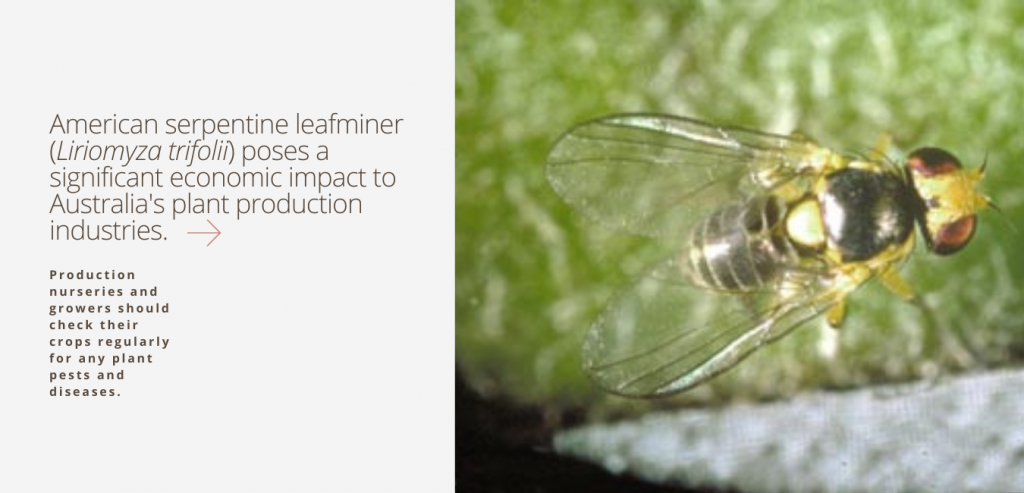
Advice
Production nurseries and growers should check their crops regularly for any plant pests and diseases.
If you suspect you have an ASLM infestation, report it to the department of primary industries or agriculture that is relevant to your state or territory. You can do this by ringing the Exotic Plant Pest Hotline on 1800 084 881.
Implement good on-farm biosecurity practices to prevent further incursions.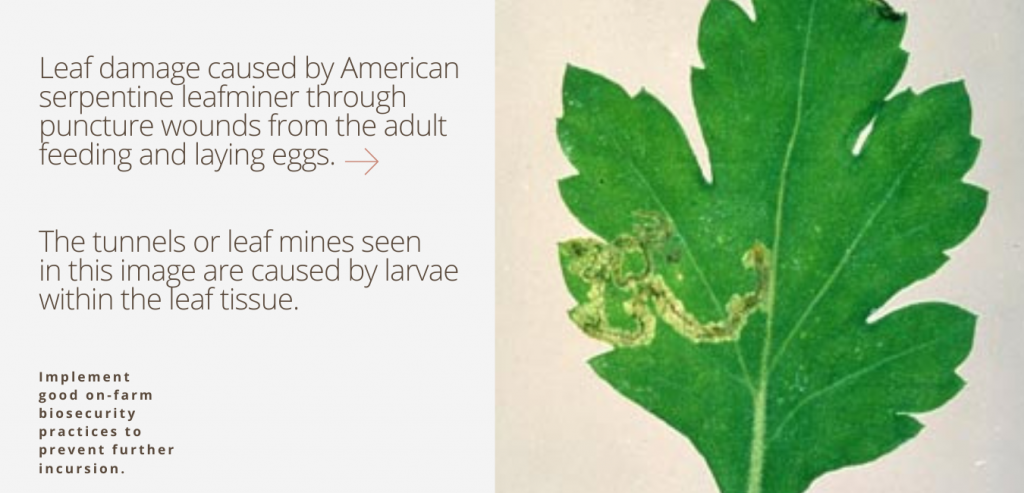
Impacts to trade
EXPORTS
ASLM is present across large areas of Africa, Asia, Europe and the Americas and this suggests that trade issues are likely to be limited if the pest establishes in Australia. However, there are several certification requirements, mainly for seeds, for this pest in the Manual of Importing Country Requirements (MICoR) which may cause some trade implications.
Australian exporters will be notified by the Department of Agriculture, Water and the Environment should importing countries change their requirements.
IMPORTS
The ASLM incursion is not expected to change import conditions for the import of plant material into Australia. General pre-export conditions are applied offshore and manage the risk of ASLM.
DOMESTIC TRADE
Domestic trade restrictions will be considered further by the consultative committee once work to identify the extent of outbreaks in QLD and WA is undertaken, and a final decision is made on technical feasibility of eradication.
There are restrictions already in place in QLD, on the movement of carriers of ASLM from Torres Strait and Cape York Peninsula.
For more information about American serpentine leaf miner, please contact AUSVEG at science@ausveg.com.au.
Images courtesy of Central Science Laboratory, Bugwood.org.
DISCLAIMER: The material on this webpage is for general information only and no person should act, or fail to act on the basis of this material without first obtaining professional advice. AUSVEG and all persons acting for AUSVEG expressly disclaim liability with respect to anything done in reliance on this publication.


